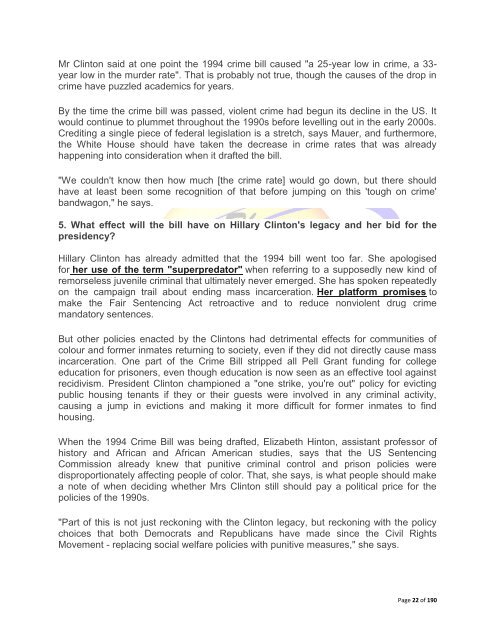The Violent Crime and Law Enforcement Act of 1994
The Violent Crime and Law Enforcement Act of 1994
The Violent Crime and Law Enforcement Act of 1994
Create successful ePaper yourself
Turn your PDF publications into a flip-book with our unique Google optimized e-Paper software.
Mr Clinton said at one point the <strong>1994</strong> crime bill caused "a 25-year low in crime, a 33-<br />
year low in the murder rate". That is probably not true, though the causes <strong>of</strong> the drop in<br />
crime have puzzled academics for years.<br />
By the time the crime bill was passed, violent crime had begun its decline in the US. It<br />
would continue to plummet throughout the 1990s before levelling out in the early 2000s.<br />
Crediting a single piece <strong>of</strong> federal legislation is a stretch, says Mauer, <strong>and</strong> furthermore,<br />
the White House should have taken the decrease in crime rates that was already<br />
happening into consideration when it drafted the bill.<br />
"We couldn't know then how much [the crime rate] would go down, but there should<br />
have at least been some recognition <strong>of</strong> that before jumping on this 'tough on crime'<br />
b<strong>and</strong>wagon," he says.<br />
5. What effect will the bill have on Hillary Clinton's legacy <strong>and</strong> her bid for the<br />
presidency?<br />
Hillary Clinton has already admitted that the <strong>1994</strong> bill went too far. She apologised<br />
for her use <strong>of</strong> the term "superpredator" when referring to a supposedly new kind <strong>of</strong><br />
remorseless juvenile criminal that ultimately never emerged. She has spoken repeatedly<br />
on the campaign trail about ending mass incarceration. Her platform promises to<br />
make the Fair Sentencing <strong>Act</strong> retroactive <strong>and</strong> to reduce nonviolent drug crime<br />
m<strong>and</strong>atory sentences.<br />
But other policies enacted by the Clintons had detrimental effects for communities <strong>of</strong><br />
colour <strong>and</strong> former inmates returning to society, even if they did not directly cause mass<br />
incarceration. One part <strong>of</strong> the <strong>Crime</strong> Bill stripped all Pell Grant funding for college<br />
education for prisoners, even though education is now seen as an effective tool against<br />
recidivism. President Clinton championed a "one strike, you're out" policy for evicting<br />
public housing tenants if they or their guests were involved in any criminal activity,<br />
causing a jump in evictions <strong>and</strong> making it more difficult for former inmates to find<br />
housing.<br />
When the <strong>1994</strong> <strong>Crime</strong> Bill was being drafted, Elizabeth Hinton, assistant pr<strong>of</strong>essor <strong>of</strong><br />
history <strong>and</strong> African <strong>and</strong> African American studies, says that the US Sentencing<br />
Commission already knew that punitive criminal control <strong>and</strong> prison policies were<br />
disproportionately affecting people <strong>of</strong> color. That, she says, is what people should make<br />
a note <strong>of</strong> when deciding whether Mrs Clinton still should pay a political price for the<br />
policies <strong>of</strong> the 1990s.<br />
"Part <strong>of</strong> this is not just reckoning with the Clinton legacy, but reckoning with the policy<br />
choices that both Democrats <strong>and</strong> Republicans have made since the Civil Rights<br />
Movement - replacing social welfare policies with punitive measures," she says.<br />
Page 22 <strong>of</strong> 190
















